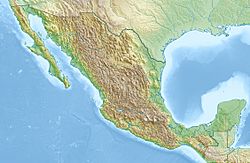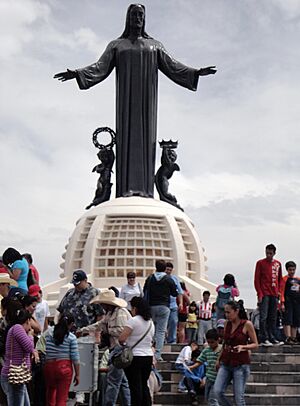Silao facts for kids
Quick facts for kids
Silao de la Victoria
|
||
|---|---|---|
|
City
|
||
 |
||
|
||
| Nickname(s):
Silao
|
||
| Country | ||
| State | Guanajuato | |
| Founded | February 3, 1833 | |
| Area | ||
| • City | 12.1 km2 (4.7 sq mi) | |
| • Municipality | 538.5 km2 (207.9 sq mi) | |
| Elevation | 1,780 m (5,840 ft) | |
| Population
(2020 census)
|
||
| • City | 83,352 | |
| • Density | 6,889/km2 (17,840/sq mi) | |
| • Municipality | 203,556 | |
| • Municipality density | 378.01/km2 (979.03/sq mi) | |
| Demonym(s) | silaoense | |
| Time zone | UTC-6 (CST) | |
| • Summer (DST) | UTC-5 (CDT) | |
| Mexican Postal Code |
36100
|
|
| Area code(s) | 472 | |
| Website | http://www.silao.gob.mx | |
Silao, officially known as Silao de la Victoria, is a lively city in the middle-west part of Guanajuato, a state in Mexico. It is the main city of the municipality that shares its name. In 2005, about 66,485 people lived here, making it the seventh-biggest city in Guanajuato. Silao is an important place for farming and factories.
Contents
Getting to Silao: The Airport
Silao is served by the Del Bajío International Airport. This airport is a key travel hub for several nearby cities. It connects places like Irapuato, Guanajuato, León, Salamanca, and San Miguel de Allende.
What's in a Name: Silao's History
The area where Silao is now was first called Tsinäkua. This name came from the Otomi language spoken by the Otomi and Purépecha native groups. Tsinäkua means 'place of dense fog'. This name came from the steam rising from hot springs in the Comanjilla area.
Over time, the name changed. After the Spanish arrived, it became 'Sinaua', then 'Silagua', and finally 'Silao'.
Where is Silao: Geography
Silao is located in the Mexican state of Guanajuato. It sits at an altitude of 1,780 meters (about 5,840 feet) above sea level.
The municipality of Silao covers an area of 538.5 square kilometers. This is about 1.76% of the entire state of Guanajuato. To the east and north of Silao is the city of Guanajuato. To the south is Irapuato. To the west is Romita, and to the northwest is León.
Land Features: Geology
Most of Silao's land is flat, part of a region called the Bajío. One of its most important hills is the 'Cerro del Cubilete'. This hill is 2,570 meters (about 8,430 feet) high. It is even thought to be the geographic center of Mexico!
Waterways: Hydrography
The Silao River flows through most of the municipality. Smaller streams like Magueyes, Pascuales, Hondo, and Tigre feed into it. The Gigante River is its largest branch. Other important streams in the area include Agua Zarca, San Francisco, El Paraíso, Pabileros, and Aguas Buenas.
Silao's Weather: Climate
Most of Silao has a semi-dry climate. This means it gets rain in the summer. The average temperature is about 28 °C (82 °F). In June, temperatures can reach 34 °C (93 °F). In December and January, it can get as cold as 0 °C (32 °F).
In the northeastern part of Silao, the climate is also semi-dry. Temperatures there are usually above 28 °C. The area gets between 600 and 800 millimeters (23 to 31 inches) of rain each year.
How Silao Makes Money: Economy
Silao is a hub for farming and industry. Many different crops are grown here. There are also plants that package fresh produce and dairy products.
Big companies have factories in Silao. General Motors has a plant that builds trucks and SUVs. In 2016, this plant made one-third of all Chevrolet and GMC full-size pickup trucks. Volkswagen also has an engine factory here. Plus, Pirelli makes tires in Silao.
Who Lives in Silao: Population
According to a census in 2005, the municipality of Silao had 147,123 residents.
Different Cultures: Ethnic Groups
A small number of people in Silao are from indigenous groups. In 2005, there were 203 indigenous residents, which was about 0.15% of the total population. The main native languages spoken are Mazahua and Nahuatl.
The municipality has about 250 people living per square kilometer. The population grows by about 1.6% each year.
Beliefs: Religion
Most people in Silao are Roman Catholic. In 2000, about 95.8% of the population followed this religion. About 1.8% were Protestants and Evangelicals. Another 1.4% followed other religions. The remaining 1% either said they had no religion or did not specify.
Old Buildings and Art: Historic Monuments
Silao has many interesting old buildings and monuments:
- Parroquia de Santiago Apóstol: This church started being built in the late 1600s and finished in 1728. It has a neo-classical style.
- Templo del Santuario: Another church built in the late 1600s.
- Templo de la Casa de Ejercicios: This building was constructed in 1834.
- Palacio Municipal: This building used to be the city jail and main offices.
- Mercado González Ortega: This is the main market in Silao.
- Monument to Cristo Rey (Christ the King): This huge monument is on the 'Cerro del Cubilete'. It stands 20 meters (about 65 feet) tall from its feet to its head. Building started in 1945 and finished in 1949. The 'Cerro del Cubilete' is considered the geographic center of Mexico.
- Casa de Mauricio Ruiz: This is a historic house. It was the home of the Mexican artist Mauricio Ruiz Chávez.
Fun Things to See: Tourist Attractions
Silao offers several attractions for visitors:
- Cerro del Cubilete and Cristo Rey: You can find the Cerro del Cubilete here, which some believe is the geographic center of Mexico. At the very top of this mountain (2,500 meters high) is a large monument to Cristo Rey, or Christ the King. It stands for the unity of the people of México in their Catholic faith. This area was important during the Cristero War, a conflict where people fought for their faith. The monument was built between 1945 and 1949. It is 20 meters tall and offers amazing views of the 'Bajío' region around Silao.
- Museum of the Chávez Morado Brothers: This museum features the works of famous muralists and sculptors.
- Churches and Historic Buildings: Silao has 27 churches and many other buildings rich in history and beautiful architecture.
- Casa de la Cultura: This building, now a cultural center, used to be military headquarters.
Silao is also a great starting point to visit other interesting cities. Guanajuato and Romita are only about 25 minutes away by highway. León and Irapuato are about 35 minutes away.
Modern Growth: Business District
A new business district is being developed in an area called Guanajuato Puerto Interior. This district is planned to include hotels, banks, and other commercial buildings.
See also
 In Spanish: Silao para niños
In Spanish: Silao para niños





